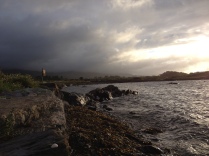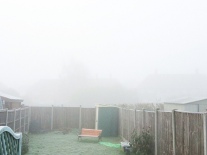
Near Keswick, Cumbria.
It doesn’t usually look like this.
Friday evening. We’re driving through Cumbria in the north of England, on our way to a friend’s wedding. Thanks to illness, it’s the first time I’ve been out of the house in about three weeks, and I’m not too comfortable – but we’re not far away. We’re on beautiful mountain roads, sheer drop down to the lake valley on our right, rugged peak rising off to our left.
And then the snow starts falling.
As the sun sets, it gets hard to tell what’s road, what’s sky, and what’s snow. At first I think this is glorious fun. The roads are never dangerous in England. (In my head, rural England is basically the Shire. Which, of course, it is.)
And then the snow starts falling faster. A few minutes later, we’re in something closely resembling a blizzard. We don’t get really severe weather here, and we’re not used to snow. It’s a bit like when it rains in desert countries and everyone forgets how to drive. If we’d even thought of putting on winter tyres, as we later heard some of the other wedding guests did, none of the events that were about to unfold would have been a problem – but who needs snow tyres in England? The most we ever get is an inch or two, and that rarely.
Within less than an hour, there was a foot of snow on the road, and of course no sign of any snowploughs yet (because, again, snow does not come down that fast in this country). We were only about twenty miles away from our destination when we started allowing ourselves to consider that we might not make it. I was working extremely hard on staying calm – something that isn’t easy for me at the best of times – and I’m very proud to say that I only hyperventilated briefly. That was when the road dropped away beneath us into a very steep slope that I was completely sure my practical-for-cities minivan was not going to cope with. (It was only later that SJ, of the eternal calm, admitted that I wasn’t the only one who thought we were about to fall off the side of a mountain.)
A few miles on and one brief stop later (we paused to consider our options, and realised that ‘keep going’ was the only alternative to ‘stay here and freeze’), we turned a corner and met a row of blinking lights. A car had got stuck on a very steep hill and was now being pushed up. The car behind it ended up in the same situation. We stopped and waited for about half an hour.
By this point I was praying at a pitch and intensity not seen since my Christian days. In an emergency, my brain stops working, and I always end up having to quiz my wife about which god I should to talk to. (SJ is an atheist who knows my gods fairly well. At our own wedding, our vows were based on the text from the Book of Ruth: “Your people shall be my people, and your god shall be my god.” A whole new religion later, SJ faithfully honours that promise.) This time, I realised the irony of asking the “Who shall I pray to?” question while our car clung to the side of a snow-covered mountain in a blizzard. Oh, come on.
So it was that, while SJ went to help push the other cars up the hill, I called out to my mountain goddess of the wild. And got the distinct impression of being laughed at.
Just then, I looked up to see SJ talking to a man who was stepping out of the car in front of us. He was putting on a jacket, red with reflective silver patches. It had ‘MOUNTAIN RESCUE’ written across the back.
Oh, I laughed.
SJ told them we were worried about our car’s ability to make it over the hills, and that I was disabled and wouldn’t be able to help push if we got stuck. They offered to follow us the rest of the way to our destination. We did indeed, eventually, get stuck – not far from home, but far enough. It could have been a long wait for help if they hadn’t been there.
It took us an hour to drive about the last ten miles of our journey.
Later, I was oddly stoical about the other snow- and cold-related frustrations. When we got to the cottage we’d rented for the weekend and found that it was only about 10 degrees C inside, with no way to contact the owners. And the next day, when our car was snowed in, and I had to walk several hundred metres in the snow on crutches so that a taxi could get us out of there. There are worse things, really.

Stranded on the morning of the wedding. You’ll see from the tracks that we only made it half-way up the hill.
Of course, that didn’t stop us moving to a warm hotel last night. I’m not keen on inviting the forces of the wild inside too often.
SJ and I are both still somewhere between a) freaked out by events, and b) marvelling that they worked out so well. If we hadn’t filled the tank with petrol even though we didn’t desperately need it… if we had left home half an hour later than we did… if we had taken the M6 motorway (where several of our friends were stuck until 3am) instead of the A1… if we hadn’t been behind that particular car… And really, we wouldn’t have been in *that* much trouble. It would have been a case of waiting a few hours for emergency services (if we’d had phone reception to call them), maybe a bit longer if we’d been in the M6 tailback. The chances of us actually falling off the side of the mountain were low. With my condition, though, and the way it reacts to the cold, I’d have been dealing with some fairly major health problems very quickly.
And we all beat those kinds of odds every day, and even more unlikely ones. That’s the only way any of us managed to be born, the only way any of us have survived this far. But when civilization wraps its thin mantle around us, we forget that, moment by moment, we are still at the mercy of some incredible natural forces. Brick houses and central heating and reliable cars can’t hold those forces off forever.
On a forum where I post, several questions have been asked recently that are variations on ‘What are we to the gods?’ I’ve been enjoying a lot of reading on that question – not just there, but in books, in blogs like Pagan Layman’s, and in conversation. But, to me, no theological mystery-pondering can ever be as thrilling and disturbing as encountering the terrifying forces of life and the wild that are my gods – face to face, spirit to spirit, their great flood to my tiny spark. It doesn’t help me to know what the answer is to the question, but it does clarify the terms.
Was it in response to my prayer to Cailleach Bhearra that the mountain didn’t claim us? Unlikely. The mountain didn’t care whether I lived or died, whether I was rescued or spent the night in my car in sub-zero temperatures. But I will give grateful offerings anyway, and remember the natural forces by whose whims I survive, however much I pretend otherwise.
And I’ll keep open the possibility that She heard me. I’ve experienced stranger things.
There was a box at the bar of our hotel marked ‘Keswick Mountain Rescue’. I put in all the money I had on me. I’ll look into making more regular donations to them. Seems appropriate.























